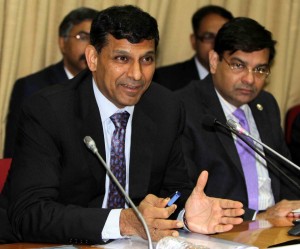 With the inflation rate coming down to below eight percent by January 2015 as targeted and likely to be below six percent by January 2016, the Reserve Bank of India (RBI) has reduced the repo rate by 25 basis points, said bank Governor Raghuram G. Rajan.
With the inflation rate coming down to below eight percent by January 2015 as targeted and likely to be below six percent by January 2016, the Reserve Bank of India (RBI) has reduced the repo rate by 25 basis points, said bank Governor Raghuram G. Rajan.
The much awaited reduction in key interest rates by the RBI governor also fulfilled his promise made at the last monetary policy review to cut key lending rates as soon as inflation eases.
The move came as a surprise as it broke away from the standard RBI practice of announcing the lending rates every two months in a financial year.
The announcement, though anticipated, was expected to be made at the next monetary policy review meeting scheduled for Feb 3.
After the surprise move, equity markets, especially interest sensitive stocks, zoomed. Bonds and rupee too surged drastically.
In a statement, Rajan said: “In its public interactions, the RBI had committed to initiate the process of monetary easing as soon as data indicated that medium term inflationary targets would be met.”
He said with this commitment in mind, it has been decided to reduce the policy repo rate (the rate at which RBI lends to commercial banks) under the liquidity adjustment facility (LAF) by 25 basis points from 8.0 percent to 7.75 percent with immediate effect.
Rajan also said the RBI has decided to keep the cash reserve ratio (CRR) of scheduled banks unchanged at four percent of net demand and time liabilities (NDTL).
He said the RBI would continue to provide liquidity under overnight repos at 0.25 percent of bank-wise NDTL at the LAF repo rate and liquidity under 7-day and 14-day term repos of up to 0.75 percent of NDTL of the banking system through auctions, and continue with daily variable rate repos and reverse repos to smooth liquidity.
Consequently, the reverse repo rate under the LAF stands adjusted to 6.75 percent, and the marginal standing facility (MSF) rate and the Bank Rate to 8.75 percent with immediate effect, he said.
According to him, lower than expected inflation has been enabled by the sharper than expected decline in prices of vegetables and fruits since September, ebbing price pressures in respect of cereals, and the large fall in international commodity prices, particularly crude oil.
“Crude prices, barring geo-political shocks, are expected to remain low over the year. Weak demand conditions have also moderated inflation excluding food and fuel, especially in the reading for December. Finally, the government has reiterated its commitment to adhering to its fiscal deficit target,” Rajan said.
Lauding the RBI’s move, Federation of Indian Chambers of Commerce and Industry’s (FICCI) president Jyotsna Suri pointed out that the cost of finance was an important factor for giving boost to the industrial sector, which has been under stress for a long time now.
“This measure will help in improving the investor sentiment. FICCI hopes that this will be the beginning of further cuts in the policy rate by the central bank, and will enable its transmission into lower lending rates by the banks,” Suri said.
Commenting on the policy announcement, Confederation of Indian Industry (CII) director general Chandrajit Banerjee said the rate cut would propel investment demand, spur spending in rate-sensitive consumer durables and give a fillip to construction activity.
“Going forward, CII hopes that while maintaining a delicate balance between growth and inflation, the RBI would shift its stance in favour of growth, given that the trend in inflation is clearly subdued,” Banerjee said.
The Associated Chambers of Commerce and Industry of India (Assocham) also applauded the RBI decision and observed that the move has correctly assessed the industry’s need.
“The RBI view that any further cut in rate would depend upon further moderation of food inflation and current account deficit is well acknowledged. This move will bring cheer for industry, economy as whole and for the common man,” said Rana Kapoor, Assocham president.
According to the PHD Chamber of Commerce and Industry, the rate cut will play a major role in the revival of industrial activity.
The industry body’s president Alok B. Shriram said industrial activity should be at utmost priority and implementation of recent reform measures to ease doing business in India are expected to re-capture the growth momentum.